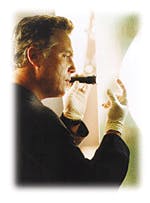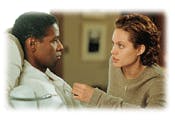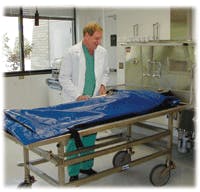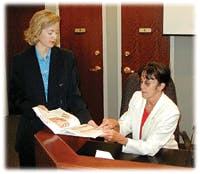Defining forensic pathology
The primary role of the forensic pathologist is to determine the cause and manner of death. In most jurisdictions, the manner of death is limited to one of five categories: homicide, suicide, accident, natural and undetermined.
Another equally important duty of the forensic pathologist is to make sure that the deceased is correctly identified. This can be as simple as visual identification of the deceased by a family member or friend, or comparison with a drivers license photograph. In other cases, if no family or friends are around, fingerprints can be used, as long as there are any that were made antemortem that can be obtained for comparison. This requires the services of the local police crime lab and its fingerprint experts. Burn victims, terribly decomposed bodies and skeletal remains may require the services of a forensic odontologist to compare dental records or, lacking those, a forensic anthropologist to evaluate the bones for determination of sex, age and ethnicity. The anthropologist is also invaluable in determining if there are subtle signs of injury to bones that might suggest a violent death. If there is usable tissue, a DNA lab can make the identification, if comparison DNA can be found. Plainly, the forensic pathologist does not work alone; he needs a whole host of other experts to help.
The proof lies in details
An important duty of the forensic pathologist is to determine the time of death, and that determination cannot be done as accurately as it is on television or in films. A rough approximation is the best that real-life forensic pathologists can do. Never is there a theory so specific between 2 and 3 this morning as that of a TV or movie medical examiner, unless, of course, the deceased was last seen by a neighbor at 2:00 a.m. leaving the local bar and found dead at 3:00 a.m. by a passerby outside the bar. A whole book2 has been written covering various parameters such as
livor mortis (the pooling of the blood in the dependent portions of the body after death),
rigor mortis (stiffening of the body), the temperature of the body when found, potassium levels in the vitreous humor (the eye fluid) and a whole host of other factors none of which give hard-and-fast rules for determining the time since death.
The problem is, there are too many variables. Take body temperature. A simple rule of thumb used years ago said a body under normal conditions cooled an average of 1.5F to 2.0F per hour for the first 12 hours and then 1F for the next 12 to 18 hours,3 assuming, however, the body was 98.6F at the time of death. If the victim were fighting off an attack or exercising, the temperature could be four or five degrees
above normal. If the person were suffering from hypothermia, he could be four, five or more degrees
below normal. The body
habitus makes a great deal of difference Jack Spratt would cool off much more quickly than his portly wife. The ambient temperature, the type of clothing worn, whether the victim was wet or dry, all these variables can cause the above formula to be off by many hours from the true time of death. Once, I autopsied a married couple from a murder-suicide. The police initially thought that the wife carried out the shooting, because she was only slightly decomposed, while her husband was bloated and green. An examination of their wounds showed the wife had been shot in the back from a distance; the husband had a contact wound of the head. Why the difference in their appearances? She was lying on the floor in a cool north back bedroom of the house, and he was lying on the living room sofa on the south side in front of an uncovered window in full sunlight much of the day.
It takes a team
As a forensic pathologist, I had to do a number of things before I could rule on the death of a 9-week-old baby. Identification of this infant was not difficult, because his family who were active duty military brought him in to the local Army post hospital clinic. He
looked like the latest victim of Sudden Infant Death Syndrome (SIDS). This phrase, coined in the late 60s, gives a doctor a diagnosis to put on death certificates, instead of the wordier but more accurate description, We do not know why this child is dead, but we do not think there was any foul play. The baby lying on the cold steel table before me was male, chubby and the picture of health, but this little guy would never take his first step, never go to kindergarten, never graduate from high school, never earn his first paycheck, never fall in love and never have kids of his own.
As it happened, this baby did not die of SIDS. He died because one of his parents made a terrible, tragic mistake. The story of how this baby came to be lying in our morgue that day and how the circumstances of his death were discovered is as fascinating a story as any television or movie scriptwriter could concoct. This story also teaches some important lessons and illustrates how vital the laboratory is to the forensic pathologist.
A complete set of X-rays done of this infant before autopsy was negative, as was the autopsy itself. Cultures later came back negative, as did the microscopic sections. No signs of trauma indicated child abuse. Nothing indicated that this was anything other than a SIDS death. No autopsy, however, is done in a vacuum. The definition states that SIDS is the sudden death of an infant under one year of age which remains unexplained after a thorough case investigation, including performance of a complete autopsy, examination of the death scene and review of the clinical history.4 Because some types of homicide, such as suffocation, cannot be readily distinguished from SIDS, a complete investigation of the death circumstances is necessary to rule out any suspicion that the baby might have not died a natural death. The Army Criminal Investigation Division (CID) in our case reported no indications of foul play from the initial scene investigation and interviews of the parents, who had at home a smaller twin to this baby and an older sibling. For the cause of death, we had to turn to the toxicology laboratory.
The laboratorys role in forensics
The microbiologist must deal with cultures often contaminated by post-mortem microorganisms that immediately flood the body from the intestines on the circulatory system superhighways that open to them the minute death occurs. Separating the wheat from the chaff the real pathogen from all these opportunists is often problematic. Then, there are the challenges of maintaining a chain of custody on samples, which may well end up in a court case, and possibly losing a technologist for half a day while he testifies in court two years down the road. Many laboratories understandably do not wish to get involved in this, and so forensic pathologists sometimes have to search hard for a laboratory that is sensitive to their needs, or develop in-house laboratories that do nothing but forensic work.
The toxicology laboratory at the El Paso County Coroners Office in Colorado Springs is such a facility and, later on the day we received this infant, reported that there was a very high level of diphenhydramine in the babys urine. Diphenhydramine is an antihistamine (used in Benadryl) that is used in numerous over-the-counter (OTC) sleep aids and cold preparations. The Army CID was notified; they undertook another interview of the parents. Both denied giving the child any medication, but also stated the baby had been in no one elses care. Since the child was too young to crawl around and open prescription bottles on his own, it was apparent that at least one of the parents must be lying. Further analyses of liver tissue, blood and vitreous humor the next day confirmed that they, too, all had high levels of diphenhydramine. CID investigators conducted a third interview of the parents.
Faced with the inescapable fact that the infant could not possibly have gotten the drug from anyone other than a parent, the father reluctantly confessed that he had given the child 2 adult-strength tablets, or a total of 62 mg, in an attempt to quiet the fussy, colicky baby. He had hidden the medication in a cereal box before the first interview, then discarded it later. Although the CID investigators had searched the house for medications and looked in cereal boxes at the initial interview with the parents, they had not actually poured the cereal out of each box and had thus missed it. But was the diphenhydramine the actual cause of the babys death?
A tragic death
In adults, massive overdoses of diphenhydramine have been survived, and killing oneself with the substance is considered very difficult. Children, especially small infants, are a different matter. A review of the literature found several cases of toxicity manifest in young children, and an Internet query to the National Association of Medical Examiners list-serve turned up an additional four cases of diphenhydramine-related deaths in infants around the country with comparable levels to those in our case. While adults and older children experience sedation, infants and young children experience excitation. When parents give a child diphenhydramine, mistakenly thinking it will induce sleep, the child becomes more excitable, and the parents may then give additional doses, thinking that they have not administered enough. In fact, they are making matters worse. Seizures and coma and, in this case, death can result. The results of this research and the case reports for the other diphenhydramine-related infant deaths we found were published recently in the official journal of the American Academy of Forensic Science.5
In our infants case, the cause of death was certified as acute diphenhydramine intoxication, the manner was homicide. Intent to kill the infant certainly was not here, but homicide to the forensic pathologist does not require intent. It merely requires that the deliberate actions of one person result in the death of another. The father in this case knew what he did was wrong, evidenced by the facts that he neither disclosed to medical personnel nor to the investigating authorities that he had given the child an adult medication, and that he had hidden the medication before investigators arrived at his house. While citing the lack of intent, some might argue this was an accident. That scenario would have fit if the child ingested a medication lying about that he happened to find on his own, but in this case, a 9-week-old could not have done that. It was no accident the father gave the child the drug. He did it deliberately, and he knew it was wrong. A court martial agreed and convicted him of negligent homicide. He received a light sentence. No doubt, the military decided that he had already paid a far greater price for his error than it could ever demand.
Life-and-death lessons
What lessons can be learned from this case? Unfortunately, in many jurisdictions, infant deaths are signed out incorrectly as SIDS, without performance of toxicological analyses of post-mortem specimens. Even when toxicology is performed, it often is limited to a blood alcohol test and a drugs-of-abuse immunoassay screen, which will not catch OTC drugs, such as diphenhydramine. In order to find those, the much more expensive gas chromatograph/mass spectrometer, or GC/MS, screen must be performed, but many jurisdictions are reluctant to spend that kind of money on an obvious SIDS death. This case points out the necessity of doing just that, however. Without complete toxicology, the case should not be certified as SIDS.
Second, if an infant or young child comes into a hospital in a near-death state and is admitted for care, the possibility of poisoning with an OTC medication must be considered and the specimen sent for analysis. Lacking that, the specimen should at least be retained for later forensic analysis, preferably in a gray-top (sodium fluoride) tube until the infant dies or is discharged. Laboratories should have a special place to store the occasional specimen like this with a longer holding period, and clinicians should inform the laboratory that this is the case, so that irretrievable information is not lost. Not long after this particular case, we received the body of an infant who was termed a near-SIDS delayed death. He had been in the hospital over a week, and no toxicology had been done on his admission specimens. They had been thrown out, and the best we could report was that the death was undetermined, since we could not rule out a toxicological cause.
Third and finally, no autopsy stands alone. The only way to accurately determine the cause and manner of death is to integrate the autopsy findings with the findings of law enforcement, the laboratory and all the other specialists in forensic and regular medicine available to be tapped for advice. Unlike the fictional television and movie characters that are admired because of their ability to single-handedly put the minute pieces of the forensics puzzle together to solve crimes, real-world forensic pathologists rely on the contributions of other experts to draw their conclusions. Together, we are much smarter than we are alone.
References
- Randall B. Survey of forensic pathologists.
Am J Forensic Med Pathol. 2001;22:123-127. - Henssge C, Knight B, Krompecher T, Madea B, Nokes L.
The Estimation of Time Since Death in the Early Postmortem
Period. Boston, MA; Edward Arnold; 1995. - Perper JA. Time of death and changes after death. In:
Spitz WU, ed. Spitz and Fishers Medicolegal Investigation of
Death. 3rd ed. Springfield, IL; Charles C. Thomas; 1993:22. - Willinger M, James LS, Catz D. Defining the sudden infant death syndrome (SIDS). Deliberations of an expert panel convened by the National Institute of Child Health and Human Development.
Pediatr Pathol. 1991;11:677. - Baker AM, Johnson DG, Levisky JA, et al. Fatal diphenhydramine intoxication in infants.
J Forensic Sci. 2003;48:425-428.
Deborah G. Johnson is a board-certified anatomic, clinical and forensic pathologist who lives in the Colorado Springs area. In her private practice, she performs autopsies on a contract basis for several Colorado counties.
August 2003: Vol. 35, No. 8
© 2003 Nelson Publishing, Inc. All rights reserved.







